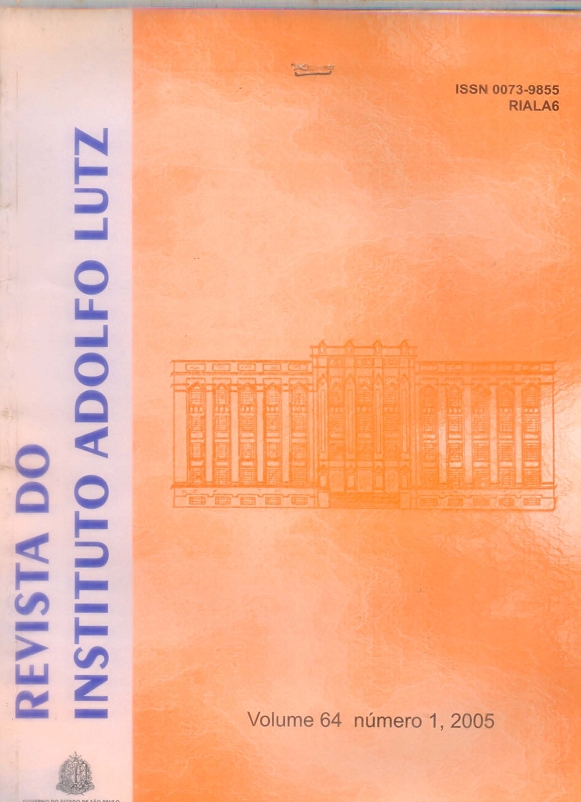Resumen
Os condimentos ou especiarias são constituídos de diferentes partes de vegetais dessecados, apresentam aroma característico e são utilizados para realçar o sabor dos alimentos. Este trabalho teve como objetivos a pesquisa de fraudes pela identificação dos elementos histológicos característicos, a adequação e implantação de métodos para pesquisa de matérias estranhas, por peneiração e flutuação em manjerona, orégano e salsa em flocos e a avaliação das condições higiênicas desses condimentos. As 41 amostras de manjerona, 84 de orégano e 57 amostras de salsa em flocos foram adquiridas no período de agosto a novembro de 1998, em seis cidades do estado de São Paulo. Para identificação dos elementos histológicos utilizou-se a técnica descrita por Rodrigues et al. e para identificação das matérias estranhas foram utilizados os métodos descritos pela AOAC-2000. Não foi caracterizado qualquer tipo de fraude nos três condimentos analisados. Das 182 amostras analisadas, 98,90% estavam em desacordo com a legislação utilizada até 07/07/2003. As ordens de insetos identificadas foram Hemiptera (afídeos), Coleoptera (carunchos) e Psocoptera (psócides) e os fragmentos de insetos foram a matéria estranha mais freqüente. O método de flutuação foi mais eficiente para a recuperação de matérias estranhas do que a peneiração, inclusive para detectar a presença de ácaros.Citas
1. Rizzini CTQ, Mors WB. Botânica Econômica Brasileira. 2a ed. Rio de Janeiro: Âmbito Cultural; 1995.
2. Correia M, Daros VSMG, Silva RP. Matérias estranhas em canela em pó e páprica em pó, comercializadas no Estado de São Paulo. CiêncTecnol Aliment 2000; 20 (3): 375-80.
3. Hill AF. Botánica Económica - Plantas Útiles y Productos Vegetales. Especias y outros productos aromaticos. Barcelona: Ediciones Omega;1965.
4. Prakash V. Leafy spices. Florida:CRC Press; 1990.
5. Resolução Normativa da Comissão Nacional de Normas e Padrões para Alimentos [CNNPA] nº 12, de 23 de julho de 1978. Aprova as seguintes normas técnicas especiais do Estado de São Paulo, revisadaspela CNNPA, relativas a alimentos (e bebidas) para efeito em todo território brasileiro. Diário Oficial [da] República Federativa do Brasil, Brasília, DF, 24 jul. 1978. Seção 1, pt 1, p. 11.521-5.
6. Decreto nº 12.486 de 20 de outubro de 1978. Aprova Normas Técnicas Especiais Relativas a Alimentos e Bebidas. Diário Oficial do Estado deSão Paulo, São Paulo, 20 out. 1978. p. 32 - 3 (NTA 70).
7. Alzugaray D, Alzugaray C, editores. Enciclopédia da flora brasileira. São Paulo: Três Livros e Fascículos, 1984.
8. Maranca G. Plantas aromáticas na alimentação. São Paulo: Livraria Nobel S.A.; 1986.
9. Gorham JR. The significance for human health is insects in food. Ann. Rev. Entomol. 1979; 24: 209-24.
10. Peace R, Gardiner MA. Extraneous matter in food: detection, identification and evaluation. Ontario: Polyscience Publications Inc.; 1990.
11. Tainter DR, Grenis AT. Especias y aromatizantes alimentarios. Zaragosa: Acribia; 1996.
12. Food & Drug Administration, U.S. - Center for Food Safety & Applied Nutrition. FDA. Macro analytical Procedures Manual, 1984. p.1-8.
13. Boese J, Cichowicz SM. Extraneous materials - isolation. In: CunniffP; editor. Official methods of analysis of AOAC International. 16thed. Arlington: AOAC International; 1995. p. 38, 44 - 5.
14. Dent RG. Extraction methods. In: Gorham JR; editor. Training manualfor analytical entomology in food industry. Washington, DC: FDA;1978. p.76-84.
15. Arbogast RT. Beetles: Coleoptera. In: Gorham JR, editor. Ecology andmanagement of food industry pests. Arlington: FDA Technical Bulletin4; 1991. p. 131-76.
16. Boczek J. Mite pests in stored food. In: Gorham JR, editor. Ecologyand management of food industry pests. Arlington: FDA Technical Bulletin 4; 1991. p. 57-79.
17. Olsen AR. Regulatory action criteria for filth and other extraneousmaterials. III. Review of flies and foodborne enteric disease. Regulatory Toxicol. Pharmacol. 1998; 28: 199- 211.
18. Olsen AR. Regulatory action criteria for filth and other extraneousmaterials. II. Allergenic mites: an emerging food safety issue. Regulatory Toxicol. Pharmacol. 1998; 28: 190-8.
19. Moecke EH, Func LG, Nazzuco RM, Morato EF. Ácaros de armazenagem causadores de anafilaxia. In: Encontro Nacional de Analistas de Alimentos. Maceió: 2001: 223.
20. Olsen AR. Regulatory action criteria for filth and other extraneousmaterials. I. Review of hard or sharp foreign objects as physical hazardsin food. Regulatory Toxicol. Pharmacol. 1998; 28: 181-9.
21. Zamboni CQ, Alves HI, Spiteri N, Rodrigues RMMS. Partículas metálicas em farinha de trigo. Rev. Inst. Adolfo Lutz.1985; 45 (1/2):27-9.
22. Rodrigues MMS, Atui MB, Correia M, editores. Isolamento de elementos histológicos. São Paulo: Letras & Letras;1999. p. 68 - 70.
23. Association of Official Analytical Chemists (AOAC). Official methodsof analysis of AOAC International. 17th ed. Gaithersburg: 2000.
24. Berquó ES, Souza JMP, Gotlieb SLD. Bioestatística. São Paulo: Editora Pedagógica e Universitária Ltda, 1980.
25. Resolução RDC no 175, de 08 de julho de 2003. Aprova o Regulamento Técnico de Avaliação de Matérias Macroscópicas e Microscópicas Prejudiciais à Saúde Humana em Alimentos Embalados. Diário Oficial [da] República Federativa do Brasil, Brasília, DF, 2003. Disponível em: http://www.anvisa.gov.br/legis/resol/2003/rdc/175_03rdc.htm. 14 abril 2004.

Esta obra está bajo una licencia internacional Creative Commons Atribución 4.0.
Derechos de autor 2005 Revista del Instituto Adolfo Lutz
